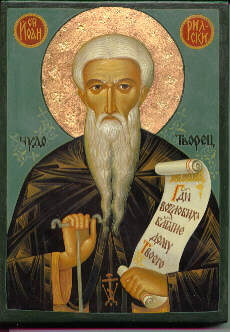- John of Rila
Infobox Saint
name=Saint Ivan of Rila
Свети Иван Рилски
birth_date=876
death_date=c. 946
feast_day=19 October
venerated_in=Bulgaria , theEastern Orthodox world
imagesize=200px
caption=Icon depicting Saint Ivan of RilaSaint Ivan Rilski (Bulgarian: Свети Иван Рилски, "sveti Ivan Rilski") (876 – c. 946) was the first
Bulgaria n hermit. He was revered as a saint when he was still alive and the legend says, that wild animals were coming to him, and birds were landing on his hands. His followers founded theRila Monastery as well as many churches in his honor. One of these churches, "St Ivan Rilski" has been discovered in 2008 in the town of Veliko Tarnovo. He is today honoured as the patron ofBulgarian people and one of the most important saints of theBulgarian Orthodox Church .Life
Saint Ivan of Rila was born app. 867 a.c. in Skrino, at the foot of the
Osogovo mountain (close to the modern city ofDupnitsa ). He was a contemporary of the reign of kingBoris I , his son Vladimir (Rassate), tzar Simeon I The Great and the son of the latter - tzar Petar I.Originally a herder, at the age 25 Saint Ivan of Rila became a priest in the "St. Dimitrii" monastery located under peak Ruen. After accepting the life of a monk he left the monastery in order to continue his life in solitude and prayer.Saint Ivan of Rila lived in isolation in various locations before going to the
Rila Mountains , where he spent the rest of his life in prayer to God and deprivation of an everyday life, settling in dark and cold caves in appalling conditions.Saint Ivan of Rila is also legendarily known to have performed a multitude of miracles in order to help people. This brought him fame throughout the country, which he did not desire and often tried to avoid contact with other people. With his growing number of followers, many young believers and supporters set up camps around his cave, seeking a blessing from him. This led the way to the creation of the
Rila Monastery , which is considered to be the foremost monastery in Bulgaria.The word of the miracles performed by the hermit also reached the capital of the Bulgarian Empire. Tzar Petar I (son of tzar Simeon I) took a 120 km. trip to the Rila Mountains in order to meet St. Ivan and seek spiritual advice. Their meeting is described in detail in one the the hagiologies of St. Ivan Rilski. After a long and exhausting trip tzar Petar I reached the place where St. Ivan Rilski lived, however upon arrival the tzar realized that the dwelling of the saint was inaccessible (probably due to the extremely rough terrain). As the medieval hagiologies point out St. Ivan of Rila refused to meet the emperor in person in order to avoid the temptation of vanity and pride due to the extraordinary visit. They only bowed to each other from a distance. The emperor sent a soldier to deliver the gifts that were brought for the saint. St Ivan of Rila kept only the a small portion of food and returned all the gold and precious gifts advising the tzar that monarchs need gold in order to protect the country and to give to the poor.
Shortly before his death (Aug 18, 946) St. Ivan of Rila wrote his "Zavet". A literary work and a moral message to his successors and to Bulgarian people.
St. Ivan of Rila is the patron saint of Bulgarian people. His dormition is commemorated each year on August 18 and, October 19.
Remains
Shortly after the saint's death, his remains, which were thought to have wonder-working powers, were transferred to
Sofia during the reign of Peter I.After Magyar King
Béla III conquered Sofia in 1183, Saint Ivan of Rila's remains were sent to the Hungarian capitalEsztergom and remained there for 4 years before being returned to Sofia in 1187.In 1194, Bulgarian Tsar Ivan Asen I ordered the remains to be moved to his capital,Veliko Tarnovo . Surviving the Turkish conquest of the city in 1393, they were returned to the Rila Monastery in 1469 with the permission of SultanMurad II .Cult
St. Ivan of Rila is considered the main patron of
Bulgaria , and he is venerated widely both in his native country as well as among theBulgarian diaspora abroad. He is traditionally regarded as the founder of theRila Monastery , aUNESCO World Heritage Site regarded as one ofBulgaria 's most important cultural, historical and architectural monuments. One ofChicago 's two Bulgarian Orthodox churches St. Ivan of Rila Church is dedicated to him, located in the Portage Park community area.Honour
St. Ivan Rilski Col onLivingston Island in theSouth Shetland Islands ,Antarctica is named after John of Rila.External links
* [http://www.pravoslavieto.com/life/10.19_st_john_of_rila.htm Pravoslavieto.com page about St Ivan of Rila]
* [http://www.piecouncil.org/pie_day.htm National Pie day which celebrates Saint Ivan's passing of the "Two Pies"]
Wikimedia Foundation. 2010.
